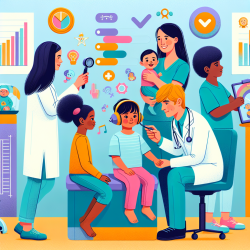Empowering Change: Harnessing Research for Resilience and Hope
In the ever-evolving landscape of education and mental health, the role of research is paramount in guiding practitioners towards effective strategies that foster resilience and well-being among students. The study titled Social–ecological theory, substance misuse, adverse childhood experiences, and adolescent suicidal ideation: Applications for community–academic partnerships offers invaluable insights into the complex interplay of factors affecting adolescent mental health and provides a roadmap for practitioners to enhance their skills and impact.
Understanding the Social-Ecological Framework
The research underscores the importance of the Social-Ecological Model, which views health as influenced by a myriad of interrelated factors at individual, interpersonal, organizational, environmental, and policy levels. This perspective is crucial for educators and mental health professionals as it emphasizes the need for a holistic approach to student well-being.
By adopting this model, practitioners can better understand how adverse childhood experiences (ACEs), such as abuse, neglect, and household dysfunction, contribute to mental health challenges like suicidal ideation. The study highlights that higher ACE scores are significantly associated with increased odds of suicidal thoughts, emphasizing the need for comprehensive interventions that address these underlying issues.
Building Resilience Through Community Partnerships
The research advocates for community-academic partnerships as a means to address these challenges effectively. Such collaborations can provide the data and resources necessary to develop targeted interventions that mitigate the impact of ACEs and promote resilience. Practitioners are encouraged to engage with local organizations, universities, and public health networks to create a supportive ecosystem for students.
- Data-Driven Interventions: Utilize data from public health surveys to identify risk and protective factors, enabling the design of tailored programs that address specific community needs.
- Multisectoral Collaboration: Partner with hospitals, schools, and community organizations to develop comprehensive strategies that encompass mental health, substance misuse prevention, and suicide reduction.
- Policy Advocacy: Advocate for policies that support mental health initiatives and provide resources for schools to implement evidence-based interventions.
Practical Steps for Practitioners
To translate these research findings into practice, educators and mental health professionals can take several actionable steps:
- Implement Trauma-Informed Practices: Train staff to recognize and respond to signs of trauma in students, creating a safe and supportive school environment.
- Foster Positive Relationships: Encourage mentorship programs that connect students with trusted adults, which can serve as a protective factor against suicidal ideation.
- Promote Physical Activity and Community Engagement: Facilitate programs that encourage physical activity and community service, both of which have been shown to reduce the impact of ACEs.
Encouraging Further Research and Collaboration
While the study provides a robust framework for addressing adolescent mental health, it also highlights the need for ongoing research and collaboration. Practitioners are encouraged to engage in continuous learning and contribute to the growing body of knowledge by participating in research initiatives and sharing their experiences with peers.
To read the original research paper, please follow this link: Social–ecological theory, substance misuse, adverse childhood experiences, and adolescent suicidal ideation: Applications for community–academic partnerships.










